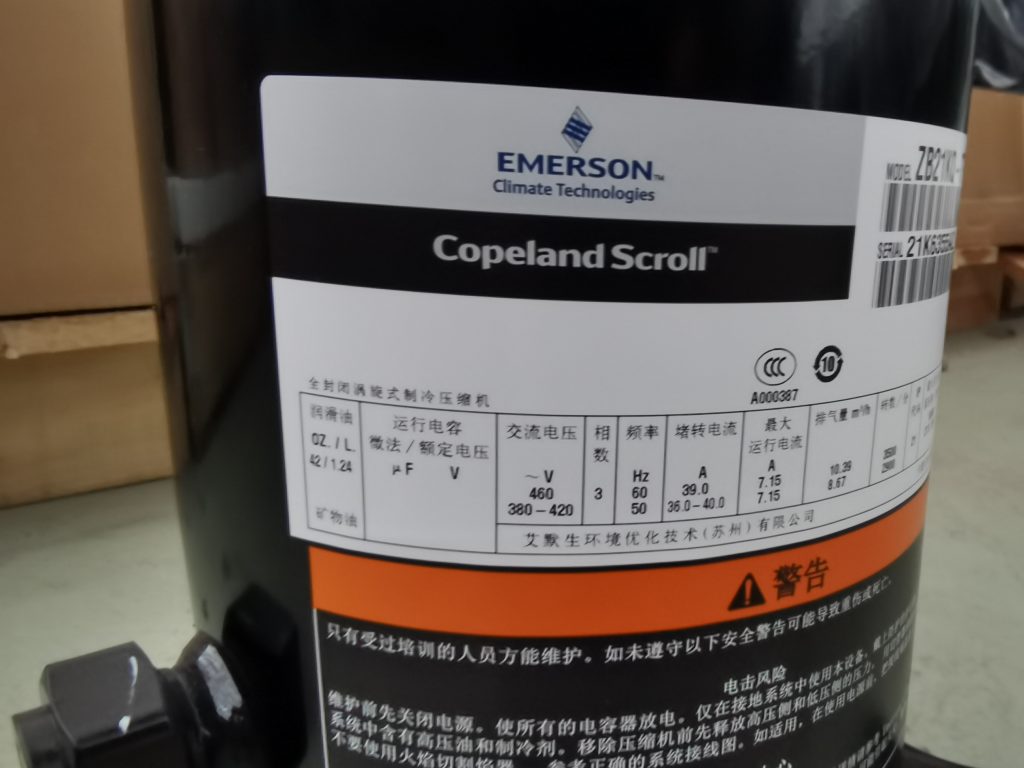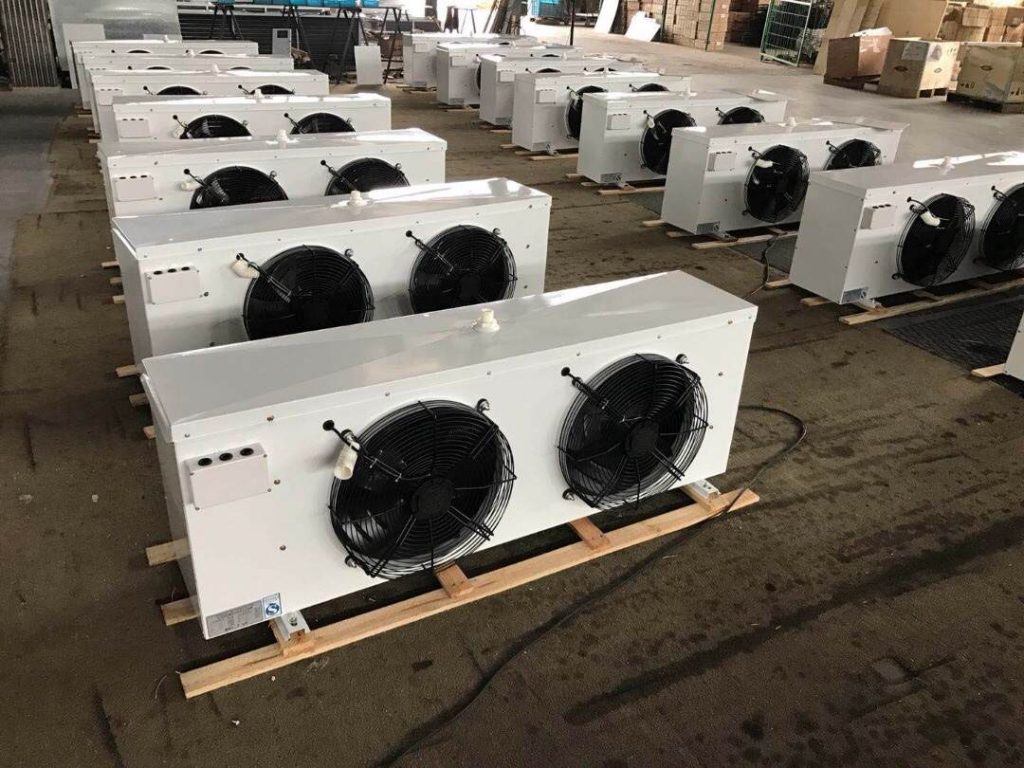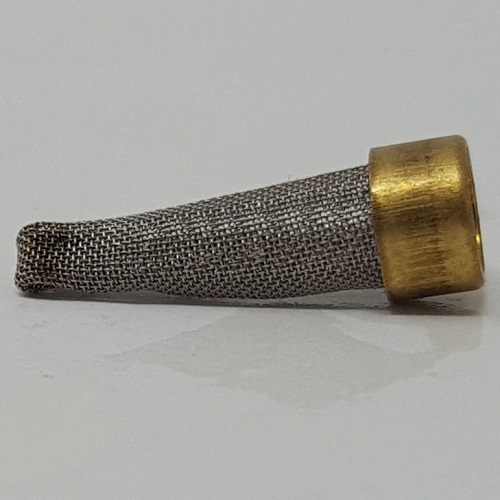Cold Room Condensing Unit is a very important type of commercial refrigeration equipment, and it’s closely related to our lives. Whether vegetables, fruits, ice cream, seafood, or special-purpose places, such as medical cold storage, cold chain transportation, etc., it must be used, so essentially you must have a comprehensive understanding of the cold room condensing unit.
Functions of Cold Room Condensing Unit Parts
Compressor
It plays the role of compressing and driving the refrigerant in the refrigerant circuit. The compressor extracts the refrigerant from the low-pressure area and compresses it, then delivers to the high-pressure area for cooling and condensation.
It emits heat into the air through the air-cooling fins, meanwhile, the refrigerant also changes from gaseous to liquid state, and finally the pressure rises.
Compressor
Condenser
It’s one of the main heat exchange equipment in the Refrigeration System of the cold storage, used to cool the high-temperature refrigerant vapor discharged from the compressor of the cold storage, or condense it into a high-pressure liquid.
Condenser
Electromagnetic Valve
1. Prevent the high-pressure refrigerant liquid from entering the evaporator when the compressor is shut down, avoid the low pressure from being too high when the compressor is running next time, meanwhile prevent the compressor from liquid strike.
2. When the temperature of cold storage reaches the set value, the thermostat starts working, while the solenoid valve loses power, and the compressor stops when the low pressure reaches the set value of shutdown. When the temperature in the cold room rises back to the set value, the thermostat works, and the solenoid valve works also. The compressor starts when the low pressure rises to the compressor set value.
Electromagnetic Valve
High and Low Voltage Protector
Prevent high pressure from being too high and low pressure too low, to protect the compressor.
High and Low Voltage Protector
Thermostat
Equivalent to the brain of the cold storage, which controls the opening and stopping of refrigeration, defrosting, and the opening and stopping of fans.
Thermostat
Filter Drier
Filtration of impurities and moisture in the system.
Filter Drier
Oil Pressure Protector
Make sure the compressor has enough lubricating oil.
Oil Pressure Protector
Expansion Valve
Also called “throttle valve”, which can make the high and low pressure of the system form a huge pressure difference, so that the high-pressure refrigerant liquid at the outlet of the expansion valve quickly expands and evaporates, absorbs the heat in the air through the tube wall, and exchanges cold and heat.
Thermostatic Expansion Valve (TXV)
What is inside the TXV
Oil Separator
Separating the lubricating oil in the high-pressure steam (discharged from the refrigeration compressor) to ensure the safe and efficient operation of the device.
According to the principle of oil separation by reducing the airflow speed and changing the airflow direction, the oil particles in the high-pressure steam are separated under the action of gravity.
Generally, when the air velocity is below 1m/s, can separate the oil particles >0.2mm diameter (contained in the steam).
Oil Separator
Evaporator Pressure Regulating Valve
Prevent the evaporator pressure (and evaporation temperature) from falling below the specified value. Sometimes adjust the evaporator pressure to adapt the load change.
Evaporator Pressure Regulating Valve
Fan Governor
Mainly used for the speed regulation of the outdoor air-cooled condenser fan motor, or the cold room evaporator.
Fan Governor
Gas-liquid Separator
To separate the refrigerant in the vapor-liquid mixed state (returned by the evaporator), thereby preventing the compressor liquid strike.
Gas-liquid Separator
Sight Glass
To observe the flow of the refrigerant. When the refrigerant is in an appropriate amount, only liquid will flow without producing white bubbles; if the system is dry, the sight core is green, otherwise it may become yellow or other colors.
Sight Glass
Cold Room Use Precautions
1. Cold Room Doors
a. To avoid damage, the Cold Room Door should lightly open and close.
b. To avoid leakage of cold air, should open or close the cold storage door whenever necessary, which also can prevent the fins of the evaporator from frosting seriously, resulting in a poor cooling effect.
2. Goods Displayed in the Cold Room
Don’t block suction and exhaust vents of the evaporator. You should keep the suction and exhaust air unobstructed, so as to ensure the uniform distribution of cooling capacity.
Must keep 5-10cm distances between stored goods.
3. Strictly Forbidden to Stack Sundries on the Top of the Cold Room
The cold room top is a non-load-bearing design and often has refrigerant piping, electrical pipelines, and so on.
So don’t put the sundries on the top of the cold room.
Cold Room Unit Installation and Commissioning
Unit Cooler Installation
1. Find the best installation location
Firstly you should consider the best location for air circulation to install the Unit Cooler (also called evaporator unit), secondly consider the direction of the cold room structure.
Unit Cooler Circuit Diagram
The gap between unit cooler and cold room inside wall should be larger than the thickness of the evaporator.
2. Tighten all slings
Should tighten all the evaporator slings when installation, meanwhile perforate and seal the bolts & slings with sealant to prevent air leakage.
When the evaporator is too heavy, you should use the No. 4 or 5 angle iron as the beam, and remember spanning the lintel to another top plate and wall plate in-order-to reduce the load-bearing.
Unit Cooler Installation
3. Installation direction
For more information about the direction of unit cooler installation, please check the “Unit Cooler” knowledge page.
Cold Room Condensing Unit Installation
1. Equip with oil separator
Both semi-hermetic and enclosed compressors should equip with an oil separator, and fill an appropriate amount of oil.
When the evaporation temperature is lower than -15°C, you should install a gas-liquid separator with appropriate amount of refrigeration oil.
2. Install rubber seat onto compressor base
Should install a shock-absorbing rubber seat onto the compressor base, remember to reserve the maintenance space when installing the Condensing Unit, which is convenient to observe instruments and adjust valves.
Condensing Unit Circuit Diagram
3. Select right copper pipe diameter
Depending on the size of the suction and discharge valve interfaces of the compressor to select the copper pipe diameter. You should increase the pipe diameter when the separation between the condenser and the compressor exceeds 3 meters. What’s more, keep >400mm distance between the suction side of the condensing unit and the wall, and keep at least 3 meters between the air outlet and obstacles.
4. Follow the nameplate
The pipe diameter of the liquid storage tank is based on the exhaust and liquid outlet pipe diameters which are indicated on the nameplate.
The suction pipeline of the compressor and the return pipeline of the evaporator shouldn’t be smaller than the size indicated on the nameplate, in order to reduce the internal resistance of the evaporation pipeline.
Semi-hermetic Condensing Unit Installation
5. Pipes need inclination
The exhaust pipe and return pipe should have a certain inclination. When the condenser position is higher than the compressor, the exhaust pipe must lean towards the condenser and install a liquid ring at the exhaust vent of the compressor, which can prevent the gas (from cooling and liquefying after shutdown) backflow to the high-pressure exhaust vent, and causing liquid compression when the machine restarted.
6. Install a U-shaped bend
You should install a U-shaped bend at the evaporator outlet of the air return pipe, and the air return line should incline toward the compressor to ensure smooth oil return.
Should install the expansion valve as close as possible to the evaporator!
Install the solenoid valve horizontally, the valve body vertically, meanwhile pay attention to the direction of liquid discharge.
Fasten the expansion valve temperature sensor with metal buckles at 100~200mm from the evaporator outlet, and wrap it with double-layer insulation.
Refrigerant Filling and Refrigeration System Commissioning
1. Measure the power supply
Measure the resistance of the compressor and the insulation of the motor.
2. Fill refrigerant
After vacuum, fill refrigerant into the liquid storage tank roughly 70-80% of the standard filling volume and then run the compressor at low pressure to fill the refrigerant into standard volume, finally set the temperature and opening state of the expansion valve according to the frosting and the cold storage condition.
Fill Refrigerant into the Cooling System
3. Pay attention to abnormal sounds
After starting the machine, first listen to whether the compressor sound is normal, check whether the condenser and evaporator are running normally and whether the compressor current is stable.
After stable cooling, check the refrigeration system all parts performance: exhaust pressure, suction pressure, exhaust temperature, suction temperature, motor temperature, crankcase temperature, expansion valve temperature, observe the frosting of the evaporator & expansion valve, and observe the oil level and if the equipment’ sound is abnormal.
4. Clean refrigeration system
The inside of the refrigeration system must be very clean, otherwise it will block the throttle holes and the lubricating oil paths.
For ammonia system: Usually use refrigeration compressor to boost the system air, and rapidly flush out the air at the lowest level of each main container (such as condenser, evaporator, liquid storage tank), so that the garbage is discharged from the system.
For freon refrigeration systems: Usually use nitrogen for blowdown, to prevent moisture in the air from entering the system.
Test Run Attention
1. Check valve condition
Check whether each valve is in the open state, especially the exhaust shut-off valve, please don’t close it.
Open the cooling water valve of the condenser. For an air-cooled condenser: turn on the fan, check the diversion.
Remember the water & air volume should meet the requirements.
2. Check electrical control
Should test the electrical control circuit separately in advance and ensure the power supply voltage is normal before running.
Keep the oil level of compressor crankcase in a normal position (generally keep it at the horizontal centerline of the sight glass).
3. Check pressure value
Check whether the indicated values of high & low pressure gauges are within the normal operating pressure range of the compressor.
Check the oil pressure gauge value:
For a compressor with an energy unloading device: Oil pressure value should be 0.15-0.3MPa higher than the suction pressure.
For a compressor without an energy unloading device: Oil pressure value should be 0.05-0.15MPa higher than the suction pressure. Otherwise, should adjust the oil pressure.
Expansion Valve
4. Check refrigerant flow
Listen to the expansion valve if has a refrigerant flowing sound, and observe whether there is normal condensation (air conditioner) and frost (cold storage) in the expansion valve pipeline.
Compressors with energy unloading should work at full load at the beginning of the operation. You can judge by sensing the temperature of the cylinder head by hand.
If the temperature of the cylinder head is higher, the cylinder is working. If the temperature of the cylinder head is low, the cylinder won’t work.
5. Check safety protection devices
The safety protection devices equipped in the refrigeration system, such as high & low-pressure relays, oil pressure differential relays, cooling water and chilled water cut-off relays, frozen water freezing protection relays, and safety valves, you should check one by one during commissioning, so as not to affect the operation of the whole system.
At the same time, check whether the values of other instruments are within the prescribed range, if any abnormal situation, you should stop and check immediately.
6. Fault checklist
The common fault during refrigeration system debugging is the expansion valve or the dry filter blockage (especially the medium and small freon refrigeration units).
The main reason is the garbage and water in the system haven’t been cleaned up, or the water content of the filled refrigerant doesn’t meet the standard.
Therefore, it is necessary to ensure the interior of the refrigerant system is clean and dry before its installation and commissioning.
Cold Room Installation Diagram
Cold Room Refrigeration System Faults and Solutions
Refrigerant Leakage
If the refrigerant leakage (because the cooling capacity is insufficient, the suction and exhaust pressure is low), you can hear an intermittent “squeak” sound at the expansion valve.
The evaporator doesn’t frost or is very small, the suction pressure still doesn’t change much after adjusting the expansion valve hole, and the equilibrium pressure in the system is generally lower than the saturation pressure corresponding to the same ambient temperature after shutdown.
Solution: Shouldn’t rush to fill the system with refrigerant! You should immediately find the leakage point, repair and then fill the refrigerant.
There are many joints and sealing surfaces in the refrigeration system with an open compressor, so there are many potential leakage points.
You must check one by one, or according to experience to find out whether the main leakage points are oil leakage, pipeline fracture, loose joints, and so on.
Refrigerant Overcharge
When the refrigerating dose in the refrigerating system after maintenance exceeds the capacity of the system, the refrigerant will occupy a certain volume of the condenser, so will reduce the heat dissipation area and its refrigeration effect, resulting in the suction and exhaust pressure is generally higher than the normal pressure value, the frosting of the evaporator is not enough and the internal decreasing temperature of the cold storage is slow.
Solution: First stop the system for a few minutes, then release the excess refrigerant at the high-pressure stop valve, which can also release the residual air in the system.
Overcharge of Refrigerant
Refrigeration System Has Air
Air will reduce the refrigeration efficiency in the refrigeration system, which is characterized by the increase of suction and exhaust pressure (but the exhaust pressure does not exceed the rated value), and the temperature at the outlet of the compressor to the inlet of the condenser increases obviously, because there is air in the system. Exhaust pressure and exhaust temperature are increased.
Solution: After a few minutes of shutdown, air can be discharged from the high-pressure globe valve several times in a row, and some refrigerants can be properly filled according to the actual situation.
Low Efficiency of the Compressor
The low efficiency of refrigeration compressor means: When the working condition is fixed, the actual exhaust capacity decreases, which leads to the corresponding reduction of refrigeration capacity.
It often occurs in the compressor which has been used for a long time, because of its large wear, large gap between the components, and the decline of the sealing performance of the valve, which leads to the decrease of the actual exhaust volume.
Solution:
a). Check whether the cylinder head paper pad is broken and causes leakage, and replace it.
b). Check whether the high and low-pressure exhaust valve plates are not closed strictly, and adjust them if necessary.
c). Check the gap between piston and cylinder. If the clearance is too large, you must adjust it.
Unit Cooler Frosted too Thick
The frost layer on the evaporator pipeline is getting thicker and thicker. When the whole pipeline is wrapped, which will seriously affect the heat transfer so that the temperature in the reservoir can’t be reduced to the required range.
Solution: Stop to defrost, and open the cold room door to allow air circulation, can also use fans to accelerate circulation to reduce defrosting time.
Mustn’t hit the frost with iron, or wooden sticks! So as to prevent damage to the evaporator pipeline.
Unit Cooler (Evaporator Unit)
Unit Cooler Pipeline Has Frozen Oil
In the process of the refrigeration cycle, some frozen oil remains in the evaporator pipeline.
After a long time use, when there is more residual oil in the evaporator, it will seriously affect the heat transfer effect and decrease the cooling performance.
Solution: Remove the frozen oil from the evaporator. Discharge the evaporator, blow-wash, and then dry.
If the evaporator can’t disassemble, you can blow out the oil by compressor pumping from the evaporator inlet.
Refrigeration System is Blocked
The refrigeration system is dirty, so after a long time of use, the dirt gradually accumulates in the filter, and some meshes are blocked, which reduces the refrigerant flow and affects the cooling effect. The expansion valve and the filter at the suction vent of the compressor are also blocked.
Solution: Discharge the blocked parts to clean, dry, then install again.
Expansion Valve Hole is Frozen or Blocked
Reason:
(1) Improper drying treatment of main components in the refrigeration system.
(2) Incomplete vacuuming of the entire system.
(3) The moisture content of the refrigerant exceeds the standard.
Solution: Insert a filter with moisture absorbent (silica gel, anhydrous calcium chloride) into the refrigeration system to filter out the moisture in the system, and then remove the filter.
Expansion Valve Filter is Dirty or Blocked
When there is a lot of coarse powdery dirt in the system, the entire filter screen will be blocked, and the refrigerant can’t pass through, resulting in no cooling.
Solution: Remove the filter, clean it, dry it, and put it back into the system.
Expansion Valve Filter
Filter Blockage
The desiccant (used for a long time) forms a paste to seal the filter or dirt gradually accumulates in the filter to cause blockage.
Solution: Replace the new desiccant, discharge the filter to clean and dry, then put it into the system again.
Refrigerant Leakage of Expansion Valve Temperature Sensor
If the temperature sensing agent in the expansion valve leaks, the two forces under the diaphragm push the diaphragm upward so that the valve hole is closed, resulting in the refrigerant can’t smoothly pass the system so as to no cooling.
At this time, the expansion valve doesn’t frost, the low pressure is vacuum, and can’t hear the airflow sound in the evaporator.
Solution: Stop and close the globe valve, and remove the expansion valve to see if the filter screen is blocked, if not, you can use mouth to blow the expansion valve inlet to feel if it is ventilated.
You can also visually inspect or take it apart for inspection and replace when it damaged.
Shutdown Caused by Low Suction Pressure
When the suction pressure in the system is lower than the set value of the pressure relay, will cut off the power supply.
Solution:
1). Fill more refrigerant, because refrigerant is probably leaked
2). The system is blocked, find the point and unblocked it.
Cold Room Condensing Unit High-Pressure Alarm
A cold room condensing unit needs to be regularly maintained, which can greatly extend its lifespan, reduce the risk of problems and failures, and thus reduce losses.
In high-temperature weather like summer, especially the high-temperature day above 35°C, the most common situation encountered by customers is the high-pressure alarm of the refrigeration system.
Semi-hermetic Condensing Unit
Reasons:
1). Cooling water (or air) flow rate is too small to take away the condensation heat of the compressor.
2). Cooling water (or air) temperature is too high, the heat exchange is not good, and the condensation heat of the compressor can’t be taken away.
3). There is air in the system, which increases the condensing pressure.
4). The refrigerant charge is too much, and the liquid occupies the effective condensing area, which increases the condensing pressure.
5). The condenser is in disrepair for a long time, and the heat transfer surface is seriously fouled (or the condenser is too dirty), which can also rise the condensation pressure. The scale also has a great influence on condensing pressure.
6). Condenser fan stops for failure, or its speed is low and the wind is small.
7). Other impurities exist in the refrigeration system, which occupy the heat exchange area of the condenser.
8). Condenser heat exchange area ratio is too small.
9). Faulty expansion valve. If the expansion valve is not functioning properly, it can cause the refrigerant flow to be restricted, leading to a rise in pressure.
Solution:
1). Check the high voltage control if there is a problem.
2). Feel the condenser temperature.
Touch the condenser of the refrigeration system. If the condenser is very hot, it means the condenser heat transfer effect isn’t good, probably the problem comes from cooling water (or condensing fan).
3). Try to release a little refrigerant.
Note: Had better contact with the professional refrigeration service provider, door-to-door troubleshooting and solving problems.
In particular, some cold storages which store a large number of goods need to be taken care of by special personnel, you should regularly check the temperature and pressure of the cold storage system, the oil level of the main engine, and deal with the potential problems as early as possible to avoid losses.
R404 in the Cold Room Condensing Unit
R404 refers to the refrigerant charged in the refrigeration system.
R404A is a mixture of HFC125, HFC-134a and HFC-143 in the ratio: R404A = 44% R125 + 4% R134A + 52% R143A.
Chemical composition: Pentafluoroethane/trifluoroethane/tetrafluoromethane mixture
Physical properties:
It is a colorless gas at room temperature and a colorless transparent liquid under its own pressure
Molecular formula: CH F2CF3/CF3CH2F/CH3CF3
Critical temperature (℃): 72.4
Liquid density (g/cm3): 1.045 (25℃)
Ozone Destruction Potential (ODP): 0
Boiling point (101.3KPa, ~C): -46.1
Critical pressure (KPa): 3688.7
Global Warming Factor Value (GWP): 3850
Conclusion
We hope this information can help you briefly understand the cold room condensing unit, if you still have any problems, can Contact Us directly, always welcome.
Any comments?
Welcome leave a message or repost.





































2 Responses
The literature is so amazing, it is so good to learn from it.
But I suggest you could had included the installation diagram and circuit diagram.
OK, thanks for the suggestion.